Strategies For Dealing With Tantrums

When your child is in the middle of a tantrum it is likely to be very difficult to control his emotions. A tantrum is an explosion of emotions that children cannot control because they cannot express in words what is happening or what is bothering them. It is necessary to learn some strategies for dealing with tantrums and understand that they are not as bad as they seem.
tantrums and small children
Tantrums seem like the most unpleasant, terrible thing… But they are just a clear sign that your child needs your support and understanding more than ever. The simplest strategies are the ones that will help you take control of the situation and make your child feel safe and cooperate to improve the situation for everyone.
Young children aged between 1 and 4 years have not yet developed enough skills to cope with the situation. But usually tantrums start because they don’t get what they want or don’t know how to express what they feel.
For children between 1 and 2 years of age, tantrums are often the result of trying to communicate a basic need but not having the necessary skills to express themselves correctly. When that happens, they get frustrated and explode to show their feelings.
For older children, tantrums are a power struggle. From the age of 3 and 4, they are gaining autonomy and are well aware of their needs and desires. They want to show that they have their own decisions and want to be respected.

ignore the tantrum
You must be very careful in this strategy, ignoring the tantrum does not mean (in any circumstances) ignoring your child and ignoring the emotions he is showing. It is to ignore the behavior and not your child. When your child is out of his mind, it’s because he’s out of control (the frontal cortex of the brain where decisions are made is blocked) and that’s why your child needs your help when he’s calmer.
make room for the child
Many children when they tantrum need their space to be able to calm down. You have to make sure there’s nothing around him that you could get hurt with because they don’t think when they’re in this sit.
action
and they are even capable of self-mutilation. Then, with your help he will be able to control his emotions and feelings, understand and be able to regain self-control. Never participate in your children’s screams or power struggles. It is necessary to give it space and a good example of emotional balance.
Find out what happens to your child
You need to find out what is creating this frustration for your child, know what brought him to this extreme emotional state. This is especially necessary for children aged two or two and a half who have a vocabulary of around 50 words and cannot link more than two words at a time.
Their vocabulary may be limited, but they have a wide range of thoughts, wants and needs. When they try to communicate and can’t, it creates a lot of frustration. It is important to teach your child alternative forms of communication to express what he wants, such as indicating following the words. For example: “plus” – plus sign – “milk” – word milk.
However, if what happens to your child is something more emotional, you need to find out what causes the discomfort. Maybe he’s afraid of the dark, doesn’t like the presence of a person, doesn’t want to wear the clothes you’ve chosen and prefers someone else, etc…
hug your children
It can be difficult for some moms and dads to hug a child when he’s in the middle of a tantrum. It’s actually something you both need right now. It is important to hug your children so that they know that despite this behavior you are not angry, but that you are on their side to help them to be well and so that they learn to control those emotions that harm them so much.
These are some ways to control tantrums so that your child feels like you are really emotionally on his side whenever he needs it.








